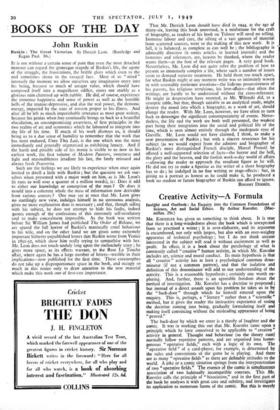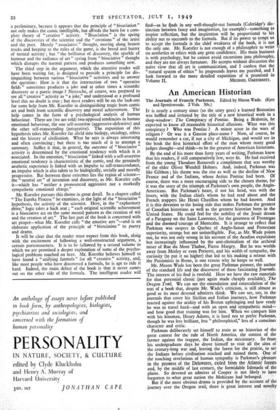Creative Activity—A Formula
MR. KOESTLER has given us something to think about. It is true that there is a long-windedness about the book which is unexpected from so practised a writer ; it is over-elaborate, and its argument is encumbered, not only with jargon, but also with an over-weighty apparatus of technical psychology ; but I do not think anyone interested in the subject will read it without excitement as well as profit. In effect, it is a book about the psychology of what is commonly called "creative" human activity, in which Mr. Koestler includes art, science and moral conduct. Its main hypothesis is that all " creative " activity has at least a psychological common deno- minator (if not a common pattern), and that the isolation and definition of this denominator will add to our understanding of the activity. This is a reasonable hypothesis ; certainly one worth ex- ploring. And, further, there is an agreeable freedom about the method of investigation. Mr. Koestler has a doctrine to propound; but instead of a direct assault upon his problem he takes us in by the " back-door " through which he himself entered upon the enquiry. This is, perhaps, a "literary" rather than a "scientific" method, but it gives the reader the instructive experience of seeing the doctrine coming into being, gradually formulating itself and making itself convincing without the misleading appearance of being "proved."
The back-door by which we enter is a theoty of laughter and the comic. It was in working this out that Mr. Koestler came upon a principle which he later conceived to be applicable to " creative" activity in general. Thought and behaviour (so the theory runs) normally follow repetitive patterns, and are organised into homo- geneous " operative fields," each with a logic of its own. The "operative field" of a card-player, for example, is determined by the rules and conventions of the game he is playing. And there are as many "operative fields" as there are definable attitudes to the world. A joke or a comic situation springs from the interpenetration of two "operative fields." The essence of the comic is simultaneous association of two habitually incompatible contexts. This Mr. Koestler calls the principle of " bisociation," and in the first part of the book he analyses it with great care and subtlety, and investigates its application to numerous forms of the comic. But this is merely a preliminary, because it appears that the principle of " bisociation" not only makes the comic intelligible, but affords the basis for a com- plete theory of "creative " activity. " Bisociation" is the spring of the discoveries of the scientist and the " creations " of the artist and the poet. Merely " associative " thought, moving along beaten tracks and keeping to the rules of the game, is the bread and butter of mental activity ; but " the brilliance of discovery, the sparkle of humour and the radiance of art " spring from " bisociative " thought which disrupts the normal pattern and produces something new.
The third step in the argument, which the attentive reader will have been waiting for, is designed to provide a principle for dis- tinguishing between various " bisociative " activities and to answer the question : How is it that the intersection of two " operative fields " sometimes produces a joke and at other times a scientific discovery or a poetic image ? Nietzsche, of course, was prepared to see all " creative " activity as " a joke," and understood at a profound level this no doubt is true ; but most readers will be on the look-out for some help from Mr. Koestler in distinguishing tragic from comic art and both from scientific discovery and moral achievement. The help comes in the form of a psychological analysis of human behaviour. There are (we are told) two opposed tendencies in human emotional behaviour, the one self-assertive (aggressive-defensive) and the other self-transcending (integrative). The exposition of this hypothesis takes Mr. Koestler far afield into biology, sociology, ethics and the history of civilisation. What he says is always interesting and often convincing ; but there is too much of it to attempt a summary. Suffice it that, in general, the outcome of " bisociativc " activity is determined by the emotional tendency with which it is -associated. In the extremes, " bisociation " linked with a self-assertive emotional tendency is characteristic of the comic, and the genuinely aesthetic experience is linked with an impulse to self-transcendance, an impulse which is also taken to be biologically, socially and morally progressive. But between these extremes lies the region of science— the " neutral art " of invention and discovery, as Mr. Koestler calls it—which has "neither a pronounced aggressive nor a markedly sympathetic emotional charge."
Mr. Koestler pursues this theme in great detail. In a chapter called " The Eureka Process " he examines, in the light of the " bisociative " hypothesis, the activity of the scientist. Here, in the "exploratory drive," logic takes a back seat ; " each original scientific achievement is a bisociative act on the same mental pattern as the creation of wit and the creation of art." The last part of the book is concerned with art proper—what Mr. Koestler calls " the emotive arts "—and is an elaborate application of the principle of " bisociation " to poetry and drama.
It will be clear that the reader must expect from this book, along with the excitement of following a well-constructed argument, a certain portentousness. It is to be followed by a second volume in which we arc promised a deeper exploration of some of the psycho- logical problems touched on here. Mr. Koestler believes himself to have found a " unifying formula " for all " creative " activity, and, like most people who have discovered a formula, he is apt to ride it hard. Indeed, the main defect of the book is that it never comes out on the other side of the formula. The intelligent reader will find—as he finds in any well-thought-out formula (Coleridge's dis- tinction between fancy and imagination, for example)—something to inspire reflection, but the inspiration will be proportional to his ability not to succumb to the formula. But if its power to tempt us to accept the formula is the chief weakness of the book, it is not the only one. Mr. Koestler is not enough of a philosopher to write on aesthetics or ethics with any great confidence. His main business is with psychology, but he cannot avoid excursions into philosophy, and they are not always fortunate. He accepts without discussion the naive view that all art is communication, and I confess that the " natural system of ethics " he propounds leaves me puzzled, and I look forward to the more detailed exposition of it promised in







































 Previous page
Previous page